Scottish Crime and Justice Survey 2018/19: main findings
Main findings from the Scottish Crime and Justice Survey 2018/2019.
This document is part of a collection
3. Focus on violent crime
What was the extent and prevalence of violent crime in Scotland in 2018/19?
There were an estimated 165,000 violent crimes in 2018/19, representing around three out of every ten crimes experienced by adults during the year.
The Scottish Crime and Justice Survey (SCJS) estimates that 165,000 incidents[14] of violent crime[15] were experienced by adults in Scotland in 2018/19. This figure accounts for 29% of all crime measured by the SCJS in 2018/19; with the remainder being property-related.
As a sample survey of the general public, SCJS results on the extent of violence are estimated values which have relatively wide margins of error around them, rather than exact counts. Further information on the process used to calculate estimates is contained within the Technical Report. Taking into account these margins of error, the SCJS estimates that there were between 121,000 and 209,000 incidents of violent crime in Scotland in 2018/19. The following analysis is focused on the best estimates for each year of the survey.
The estimated level of violent crime in Scotland has almost halved since 2008/09.
The SCJS estimates that the number of violent crimes in Scotland has fallen by 48% since 2008/09. Figure 3.1 displays the number of violent incidents estimated to have taken place by each year of the SCJS since 2008/09, demonstrating a large fall over the past decade[16].
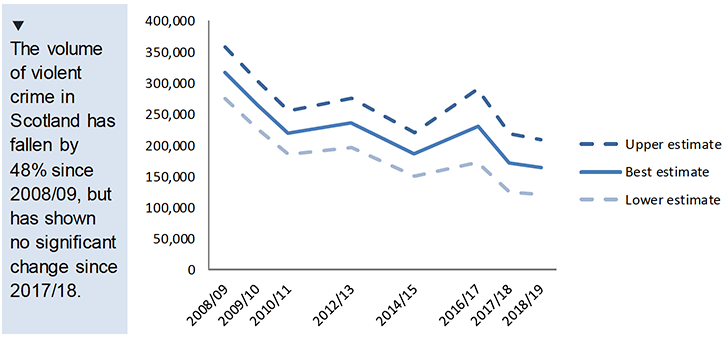
Base: SCJS 2008/09 (16,000); 2009/10 (16,040); 2010/11 (13,010); 2012/13 (12,050); 2014/15 (11,470); 2016/17 (5,570); 2017/18 (5,480); 2018/19 (5,540). Variable: INCVIOLENT
Table 3.1 examines results from key comparator years[17] and shows that the estimated amount of violent crime experienced by adults:
- has fallen by 48% since the 2008/09 baseline, from 317,000 to 165,000 incidents in 2018/19
- has shown no change since the last SCJS in 2017/18 – the apparent decrease from 172,000 violent incidents is not statistically significant
| Number of violent crimes | 2008/09 | 2017/18 | 2018/19 | Change since 2008/09 | Change since 2017/18 |
|---|---|---|---|---|---|
| Best estimate | 317,000 | 172,000 | 165,000 | down by 48% | No change |
| Lower estimate | 275,000 | 125,000 | 121,000 | ||
| Upper estimate | 358,000 | 219,000 | 209,000 | ||
| Number of respondents | 16,000 | 5,480 | 5,540 |
Variable: INCVIOLENT
The fall in violent crime over the last decade has been mostly driven by decreases between 2008/09 and 2010/11.
Violent crime estimates derived from the SCJS are based on a relatively small number of respondents who disclose experiences of such issues in the survey in any given year[18]. As a result, analysis of findings between adjacent surveys are often less likely to identify statistically significant changes. For example, all of the apparent fluctuations shown from year to year since 2010/11 in Figure 3.1 are not statistically significant.
However, where they exist, the SCJS can often identify significant changes and trends over the longer-term (such as since 2008/09 as discussed above). Taking this into account, a more detailed examination of changes in the level of violent crime over the last decade finds that the estimated number of violent incidents:
- fell markedly (by 30%) between 2008/09 and 2010/11, and has remained below the 2008/09 baseline since then
- has been more stable in recent years - for instance, the apparent fall in violence from 2010/11 to 2018/19 is not statistically significant
When looking at intermediate years, although the decrease from 2012/13 to 2018/19 is statistically significant, the wider trend and lack of significant change seen in recent years suggests this may represent fluctuation in the data. Therefore, overall the SCJS suggests that the level of violence experienced by adults in Scotland has been relatively stable since 2010/11.
The vast majority of adults in Scotland did not experience violent crime in 2018/19 and the likelihood of experiencing violent crime has almost halved since 2008/09.
Looking at the victimisation rate[19], the SCJS estimates that 2.2% of adults were victims of at least one violent crime in 2018/19. In comparison, an estimated 10.9% of adults experienced property crime over the same period.
However, like incident numbers, it is worth noting crime prevalence rates are also estimates with associated margins of error around them as they are derived from a sample survey of the population. Taking into account these confidence intervals, between 1.7% and 2.7% of the adult population were estimated to have experienced violent crime in 2018/19, with 2.2% representing the best estimate[20]. Again, as with incident counts, analysis from this point onwards will focus on the best estimates for results across the survey for each survey year[21].
Looking at trends over time, the proportion of adults experiencing violent crime has fallen from 4.1% in 2008/09 to 2.2% in 2018/19. Overall, this suggests that violent victimisation in Scotland has been relatively uncommon since 2008/09 and has become an even less prevalent experience over the last decade.
Since the last SCJS in 2017/18 there has been no change detected in the proportion of adults experiencing violent crime. The apparent decrease from 2.3% in 2017/18 to 2.2% in 2018/19, as shown in Figure 3.2, is not statistically significant.
However, as noted earlier, the SCJS is often better able to identify trends and changes, where they exist, over longer time periods. For example, looking further back reveals that the proportion of adults experiencing violence in 2018/19 (2.2%) was lower than the 3.1% in 2012/13 (and preceding years).
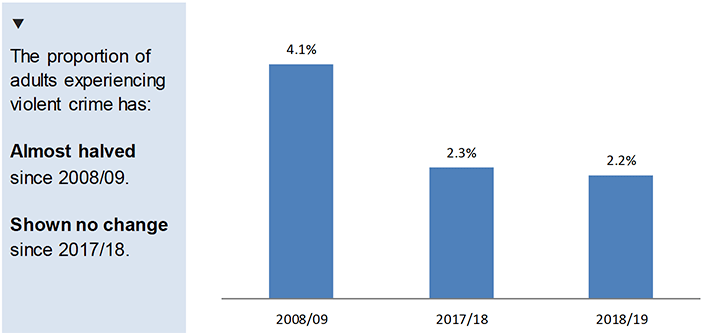
Base: SCJS 2008/09 (16,000); 2017/18 (5,480); 2018/19 (5,540). Variable: PREVVIOLENT
What types of violent crime were most commonly experienced in 2018/19?
As in previous years, the majority of violent crimes in 2018/19 were incidents of minor assault resulting in no or negligible injury.
Three-fifths of violent incidents in 2018/19 (60%) were cases of minor assault with no or negligible injury to the victim, as shown in Figure 3.3. By comparison, 7% of violent incidents in 2018/19 were serious assaults and 3% were robberies. Taken together, all categories of assault accounted for 97% of violent crime.
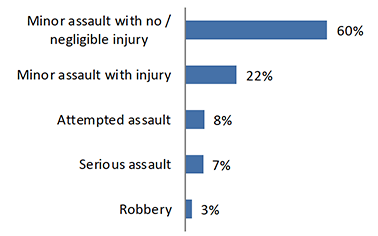
Base: 2018/19 (120). Variable: INCMINORASSNOINJURY; INCMINORASSINJURY; INCATTEMPTASSAULT; INCSERASSAULT; INCROB.
Between 2008/09 and 2018/19, the SCJS has consistently estimated that assaults (including attempted, minor and serious assaults) have accounted for around 95% of violent crime experienced by adults. As such, trends over time in the number of assaults very closely mirror wider trends in violence. The number of assaults has fallen by 46% since 2008/09 (from an estimated 297,000 incidents to 161,000), similar to overall violent crime which has fallen by 48% in the same time period.
The strength of the SCJS lies in looking at the prevalence of rare events, such as robbery and serious assault, rather than estimating the number of incidents.
Whilst sub-categories of violent crime such as robbery and serious assault are significant events for victims, these crimes represent small proportions of violence overall and are experienced by small proportions of the population (and therefore of the SCJS sample), and so this means they have relatively large degrees of error around them[22].
As such, for crime types which occur in lower volume (but which may often result in more severe physical injuries) like serious assault, the strength of the SCJS is in examining how prevalent such experiences are in the population (i.e. demonstrating that a relatively small proportion of the population are affected), rather than estimating the number of incidents of these types of crime that occur in a single year or over time. Therefore, the main body of the SCJS report focuses on the prevalence of such crimes. Estimates of the extent of these crimes are provided in the Annex tables (see Annex Table A1.2).
As (minor) assaults account for the vast majority of violent crime, it is worth noting that the later sections, which look at the characteristics of violent crime in general, will also be mainly driven by the nature of these incidents i.e. higher volume crimes that often result in less severe or no physical injuries.
Expanding the evidence on violent crime
To enhance the wider evidence base on serious assault and robbery, Scottish Government statisticians have carried out two further in-depth studies. The first, published in 2018, examined a random sample of almost 1,000 police recorded crimes of robbery, providing insights into how the characteristics of robbery have changed in Scotland between 2008/09 and 2017/18. Full details and findings can be foundon the Scottish Government website.
The second, published in 2019, used a similar approach to explore the changing characteristics of police recorded attempted murder and serious assault between 2008/09 and 2017/18. This report can be accessed via theScottish Government website.
To collate the evidence on violent crime in Scotland, the Scottish Government published areport on non-sexual violence in Scotland. This report brought together official data from a range of Scottish sources – both Criminal Justice and Health (including SCJS and police recorded crime data) – to better understand the current profile and problem of non-sexual violence in Scotland. The report was published in September 2019 and, as such, features 2017/18 SCJS data, although many of the key findings will remain unchanged with the latest SCJS data.
The likelihood of experiencing assault and robbery have both fallen since 2008/09.
Returning to SCJS findings, as in previous years, the prevalence rate for different categories of violent crime varied. An estimated 2.1% of adults were victims of any sort of assault in 2018/19, whilst 0.1% experienced robbery.
Examining trends over time, the SCJS finds that the prevalence of assault has fallen from 3.8% in 2008/09, again demonstrating a similar trend to violence overall. The proportion of adults experiencing robbery has fallen from 0.4% over the same period, as shown in Figure 3.4.
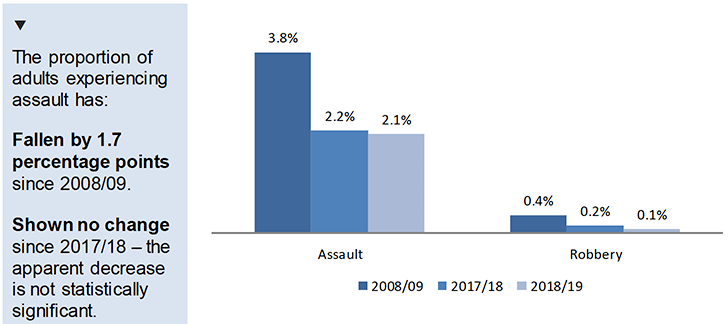
Base: SCJS 2008/09 (16,000); 2017/18 (5,480); 2018/19 (5,540). Variables: PREVASSAULT; PREVROB.
Whilst a small proportion of adults were victims of any sort of assault in 2018/19, experiences of more serious forms of violence were rarer still. This is in line with the finding that the vast majority of violent crime was accounted for by minor assaults. For instance, a greater proportion of adults experienced minor assault with no or negligible injury (1.4%) than minor assault resulting in injury (0.4%) or serious assault (0.2%).
How did experiences of violent crime vary across the population?
Those aged 16 to 24 were most likely to be victims of violence in 2018/19.
The SCJS enables us to examine how experiences of violent crime varied across the population by demographic and geographic characteristics. As shown in Figure 3.5, the likelihood of experiencing violence decreased with age (although there was no significant difference between the two middle age categories). For example those aged 16 to 24 were most likely to be victims of violent crime in 2018/19, with just over 1 in 20 experiencing violence in this age group, compared to fewer than 1 in 100 of those aged 60 and over.
The finding that those aged 16 to 24 were most likely to be a victim of violent crime is a re-emergence of earlier SCJS results – whereas in both 2016/17 and 2017/18 no significant difference was found in the likelihood of being a victim for those aged 16 to 24 and 25 to 44. The 2019/20 SCJS will shed further light on whether this represents the beginning of a sustained change.
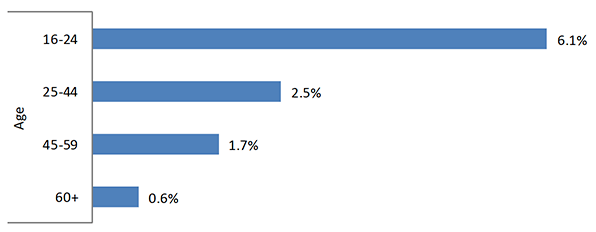
Base: 2018/19 (5,540). Variable: INCSURVEYCRIME, QDAGE.
The proportion of adults experiencing violent crime has dropped for all but the oldest age group since 2008/09; the proportion of younger adults experiencing violent crime has almost halved over this time.
Looking at trends over time, the proportion of 16 to 24, 25 to 44, and 45 to 59 year olds who were victims of violence have all decreased since 2008/09. As shown in Figure 3.6, the biggest decrease has been for 16 to 24 year olds with the proportion falling from 12.0% to 6.1% in 2018/19.
In contrast the prevalence rates for those aged 60 and over has shown no change since 2008/09.
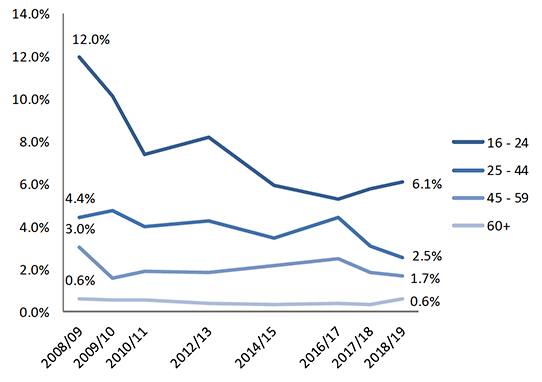
Base: SCJS 2008/09 (16,000); 2009/10 (16,040); 2010/11 (13,010); 2012/13 (12,050); 2014/15 (11,470); 2016/17 (5,570); 2017/18 (5,480); 2018/19 (5,540). Variable: PREVVIOLENT, QDAGE.
Following decreases in victimisation over the last decade, there was no difference in the likelihood of being a victim of violence by deprivation, gender, or rurality in 2018/19.
Although the victimisation rate for both those living in the 15% most deprived areas[23] of Scotland and the rest of Scotland have decreased since 2008/09, there was a greater decrease for those living in deprived areas in Scotland. This means that, unlike in previous years, the SCJS detected no difference in the likelihood of experiencing violence between adults living in the 15% most deprived areas and the rest of Scotland in 2018/19 (3.2% and 2.0%, respectively). As this finding has only emerged in the latest year, it will be important to monitor this in future to see if the similarity in prevalence is continued.
Since 2008/09, the proportion of males and those in urban areas experiencing violence have fallen, whilst the prevalence rates for females and those in rural areas have shown no change. Continuing trends seen in previous years, this means that in 2018/19 the SCJS detected no difference in the likelihood of having experienced violence by gender (2.4% compared to 2.0%, respectively), or by whether the respondent lived in an urban or rural area (2.2% compared to 1.9%, respectively).
Figure 3.7 below demonstrates how prevalence rates between these comparator groups have narrowed over the last decade – the apparent differences shown between groups in 2018/19 are not statistically significant, nor is the apparent change since 2008/09 in the prevalence rate for females, or those in rural areas.
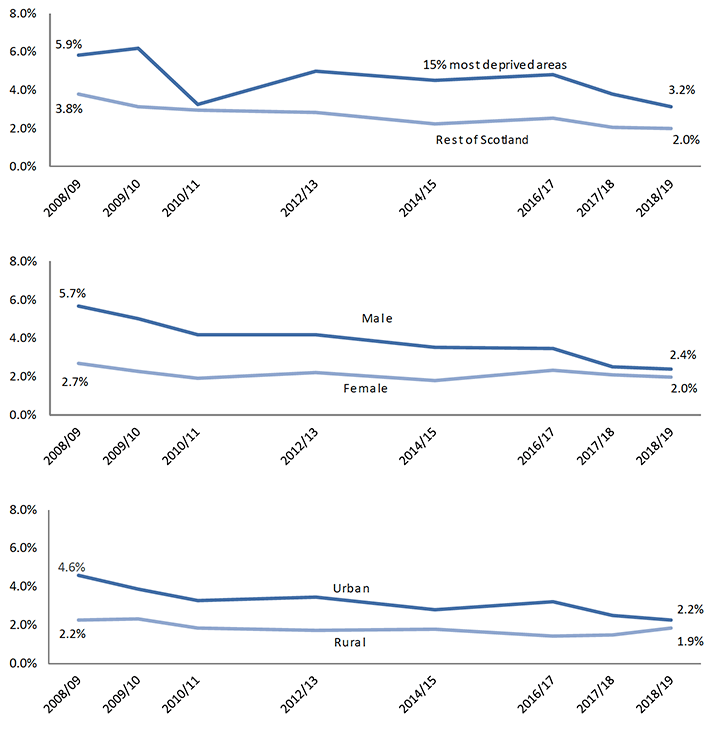
Base: SCJS 2008/09 (16,000); 2009/10 (16,040); 2010/11 (13,010); 2012/13 (12,050); 2014/15 (11,470); 2016/17 (5,570); 2017/18 (5,480); 2018/19 (5,540). Variable: PREVVIOLENT, TABQDGEN; SIMD_TOP ; TABURBRUR.
When considering findings by gender, it is important to note that victims of partner abuse may not report such experiences through the face-to-face element of the SCJS which produces the main survey prevalence rates – including on violence. As such, questions on experiences of partner abuse (covering both physical and psychological abuse) are answered in a self-completion element of the survey – with the latest key findings on this topic from 2016/17 and 2017/18 combined presented in the 2017/18 Main Findings Report. The figures showed that in the 12 month period prior to interview, experiences of partner abuse were more common for women than men (3.6% and 2.3%, respectively). The next partner abuse findings for 2018/19 and 2019/20 combined are due to be published in the 2019/20 Main Findings Report.
Looking at more recent changes in victimisation since 2017/18, there have been no statistically significant changes in the violent victimisation rate across any of the sub-population groups discussed above (including age), which is in line with the national average.
What can the SCJS tell us about repeat victimisation?
The SCJS estimates that most adults did not experience violent crime in 2018/19, whilst 2.2% of the population were victims of at least one violent crime.
However, the survey also enables us to further explore how experiences varied amongst victims and examine the concentration of crime, including what proportion of victims experienced a particular type of crime more than once during the year[24]. This is known as 'repeat victimisation'.
Further information about the approach taken to process and derive SCJS results, including on repeat victimisation, is provided in the Technical Report.
Less than 1 in every 100 adults were victims of repeated incidents of violence, but their experiences accounted for three-fifths of violent crime in 2018/19.
Table 3.2 explores the volume of crime experienced by victims in more detail to outline the extent of repeat victimisation and further unpack the concentration of violent crime amongst the adult population. It shows that 1.5% of adults were victims of a single violent incident over the year, with a smaller proportion of the population (0.7%) experiencing repeat victimisation (two or more violent crimes). These repeat victims are estimated to have experienced on average 3.1 violent crimes each during 2018/19, whilst together this group of adults are estimated to have experienced three-fifths (60%) of all violent crime committed against adults over this period. The table also highlights that an even smaller proportion of the population (0.2%) were high frequency repeat victims who experienced five or more incidents each.
Table 3.2: Proportion of violent crime experienced by victims, by number of crimes experienced in 2018/19
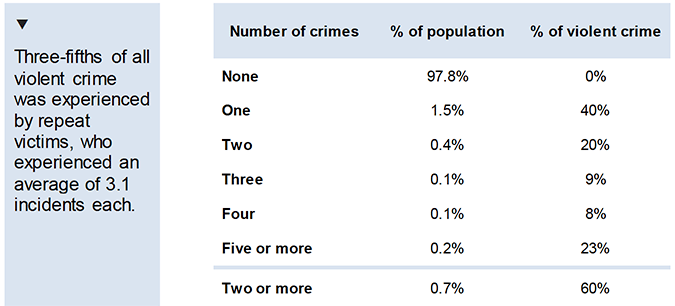
Base: SCJS 2018/19 (5,540). Variable: PREVVIOLENT, INCVIOLENT.
The proportion of victims experiencing two or more violent crimes was lower in 2018/19 than in 2008/09.
Figure 3.8 shows trends in single and repeat violent victimisation over time. It highlights that the proportion of adults experiencing only one incident of violence, and those experiencing two or more incidents, were both lower in 2018/19 than in 2008/09. Whilst this means repeat violent victimisation for two or more incidents was less prevalent in 2018/19 than a decade ago, findings comparing single years should be interpreted with caution and be considered in the context of broader trends over that period.
Looking more closely, with the exception of 2016/17, the proportion experiencing two or more violent crimes has been below the 2008/09 baseline (1.6%) since 2010/11. In 2016/17 the 1.1% estimate was not significantly different to the 2008/09 figure. This finding adds to the evidence from 2017/18 that the 2016/17 figure may have been an outlier in an otherwise declining trend[25].
On the other hand, the proportion of adults experiencing five or more incidents in 2018/19 has shown no significant change since 2008/09. This is different to last year which found that 2017/18 was significantly lower than 2008/09. This suggests the 2017/18 figure may have been an outlier in an otherwise stable trend.
All levels of violent victimisation have shown no change since 2017/18 – the apparent differences shown in Figure 3.8 are not statistically significant.
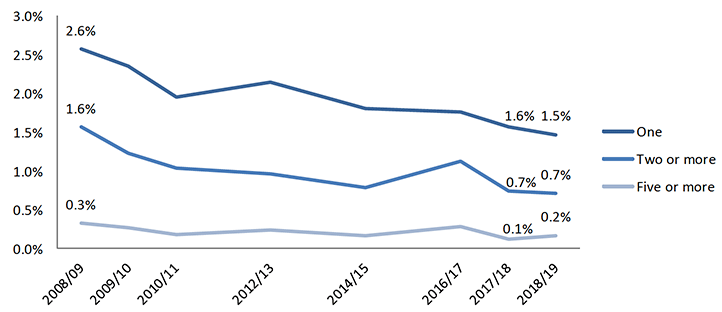
Base: SCJS 2008/09 (16,000); 2009/10 (16,040); 2010/11 (13,010); 2012/13 (12,050); 2014/15 (11,470); 2016/17 (5,570); 2017/18 (5,480); 2018/19 (5,540). Variable: PREVVIOLENT, INCVIOLENT.
Note: the 'five or more' category is a sub-set of the 'two or more' category.
Expanding the evidence on repeat violent victimisation
The Scottish Government published arapid evidence review on repeat violent victimisationin April 2019, which informed the commissioning of a qualitative study to better understand repeat violent victimisation in Scotland, in late 2019. The research is intended to inform effective, appropriate and proportionate policy responses, as well as service responses to support victims, tailored to the needs of those who experience the highest levels of violent victimisation in Scottish society. More information on the study can be found on the University of Glasgow website.
What were the characteristics of violent crime?
A similar proportion of violent crime took place in public and private settings in 2018/19.
When locations are combined into broader categories, the SCJS estimates that there was no difference in the proportion of violent crimes taking place in a public and a private space[26] in 2018/19 (46% and 54%, respectively). This is different to SCJS findings in previous years which have found that violent crimes are more likely to take place in public settings. This change is mainly driven by an increase in the proportion of incidents taking place within respondents' homes, which has increased to 33% in 2018/19 after remaining unchanged over the last decade (18% in 2017/18). As this finding differs from previous years, it will be important to monitor this in future to establish if 2018/19 is an outlier or if the nature of where respondents say crime is happening is changing.
Figure 3.9 looks at particular locations more closely and demonstrates that violent crime was experienced in a variety of settings in 2018/19, with the respondent's home the most commonly cited specific location – accounting for almost a third of violent crimes.
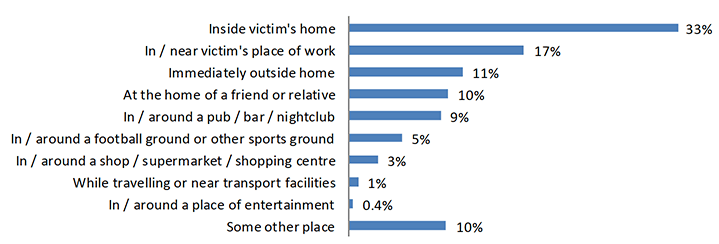
Base: Violent crime incidents (120); Variable: QWH1 / QWH3 / QWH5 / QWH7
A similar proportion of violent crime took place during the week and at the weekend.
Where respondents provided details about when an incident occurred[27], around three-fifths of violent crimes (57%) happened at the weekend, with 43% taking place during the week[28].
Most violent crime was not believed to be motivated by any discriminatory factor.
Although the SCJS did not ask directly about hate crime, respondents who had experienced violent crime were asked if they believed the incident was, or might have been, motivated by a range of motivating factors[29]. The majority (89%) of violent crimes were thought to have been motivated by none of these factors. Harassment and discrimination is discussed in more detail in Section 8.2.
Most violent crime did not involve a cyber element.
In 2018/19, respondents who had experienced violent crime were asked for the first time if the incident involved the internet, any type of online activity or an internet enabled device. Only 1% of violent crime incidents involved a cyber element. Cyber crime is discussed in more detail in Section 8.1.
What do we know about perpetrators of violent crime?
In 97% of violent incidents reported in 2018/19, respondents were able to provide some information about the offender. The section below presents headline results on the details provided[30]. All findings are proportions of cases where respondents were able to say something about the person or people who carried out the offence, unless otherwise stated.
Almost four-in-five violent crimes were committed by male offenders.
The SCJS results highlight that the majority of violent crimes in 2018/19 (79%) were carried out by male offenders only – a consistent finding over the years. A further 17% of incidents involved female offenders only, whilst in 4% of cases both men and women were responsible.
Violent incidents most commonly involved offenders under the age of 40.
Figure 3.10 shows that violent crimes involved people from a range of age groups, but only 14% involved any offenders aged 40 or over, suggesting that perpetrators tend to be from younger cohorts[31]. This finding is consistent with previous years, though the proportion of incidents involving people from the individual age categories tends to show fluctuation from year to year.
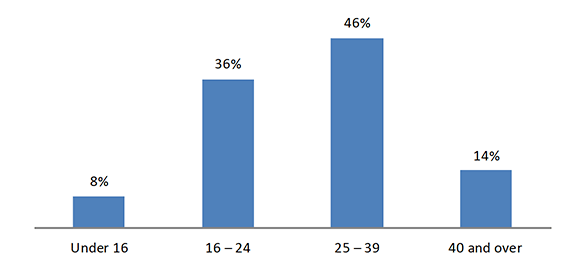
Base: Violent crime incidents where respondent could say something about offender (110); Variable: QAGE
Violent crimes often involved offenders who victims knew or had seen before.
Most violent incidents (72%) in 2018/19 were committed by people who the victims knew or had seen before. Where offenders were known by the victim, just under two-thirds of incidents (63%) were said to have involved people 'known well'.
Those who said they knew the offender in some way were asked their relationship with the offender[32]. Figure 3.11 shows the range of relationships between victims and offenders.
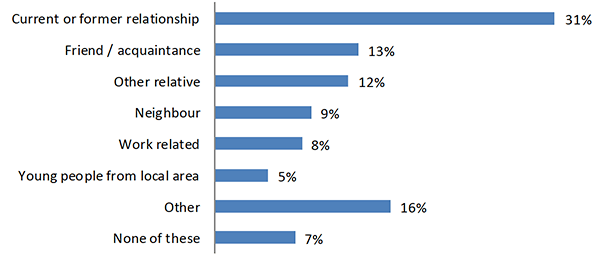
Base: Violent crime incidents where respondent knew the offender (80); Variable: QRE2
Note: 'Current or former partner' includes any current or former husband, wife, partner, boyfriend or girlfriend. 'Other relative' includes any son or daughter (in law) or other relative. 'Work related' includes any client or member of the public contacted through work, or a workmate/colleague.
When considering these findings, it is important to note that victims of partner abuse may not report such experiences through the face-to-face element of the SCJS. As such, questions on experiences of partner abuse (covering both physical and psychological abuse) are answered in a self-completion element of the survey – with the latest key findings on this topic from 2016/17 and 2017/18 combined presented in the 2017/18 Main Findings Report. The next partner abuse findings for 2018/19 and 2019/20 combined are due to be published in the 2019/20 Main Findings Report.
What do we know about the role of alcohol, drugs and weapons in violent crime?
Three-in-five violent crimes involved offenders under the influence of alcohol in 2018/19.
Offenders were believed to be under the influence of alcohol in 59% of violent incidents where victims were able to say something about the offender in 2018/19. This figure is not significantly different from the estimate in 2008/09 (63%) or 2017/18 (46%), but is higher than 2016/17 (42%). This suggests that alcohol remains a factor in a sizeable proportion of violent incidents.
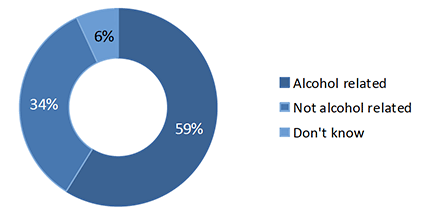
Base: Violent crime incidents where respondent could say something about offender (110); Variable: QAL
For wider context on the role of alcohol in violent crime, victims reported having consumed alcohol immediately before the incident in 32% of cases of all violent crime in 2018/19.
Relatedly, victims reported that just over two-in-five violent crimes (44%) involved offenders who were thought to be under the influence of drugs in 2018/19, up from 29% in 2008/09 and unchanged from 2017/18.
Combining this data, in 2018/19 it was found that offenders were believed to be under the influence of alcohol and/or drugs in over three-quarters (78%) of violent incidents where the victims were able to say something about the offender. This is an increase on the proportion in 2017/18 (62%) but no change since 2008/09.
Violent crime in 2018/19 did not commonly involve the presence of weapons.
Where a violent incident involved someone seeing or hearing what was going on (i.e. the victim themselves or another witness, which was the case in 97% of incidents), further questions were asked about the presence of a weapon. In 2018/19, 13% of such incidents were said to have involved perpetrators with weapons, down from 25% in 2010/11 (when the wording of this question was updated to its current format).
When combining categories (in a similar way to the police recorded crime statistics) the SCJS found that bladed/pointed articles[34] were used in 4% of violent incidents where someone saw or heard what was happening. This is unchanged from 2017/18, although due to the small sample sizes, the sub-groups of this category are prone to fluctuations. For example whilst in 2017/18 the SCJS found 7% of these crimes involved a knife, no such crimes were detected in 2018/19.
Expanding the evidence on knife crime
Over the past ten years there has been a reduction in the prevalence of weapon-carrying or the use of weapons to commit violent crime in Scotland. Despite an increase in recent years, police recorded crimes of possessing, but not using, an offensive weapon were around half the levels in 2018/19 than they were in 2008/09.
A specific study into police recorded crime found that reductions in the type of violence that typically results in more severe physical injuries, have been driven in part by fewer cases involving the use of a weapon. For example, for both Attempted murder & serious assault and Robbery, the estimated number of crimes that involved the use of a weapon fell by more between 2008/09 and 2017/18, than those that did not involve any weapon. More information can be found in the Scottish Government report on non-sexual violence in Scotland.
In addition to police recorded crime, the number of hospital admissions due to assault with a sharp object have fallen by over half (53% or 750 cases), from 1,415 in 2008/09 to 665 in 2018/19.
What was the impact of violent crime?
Around half of violent incidents resulted in injury, although serious injuries were relatively uncommon.
Where violent crime resulted in some sort of injury (56% of incidents), the most common injury sustained was minor bruising or a black eye (57%). More serious injuries like broken bones and head injuries occurred much less frequently, as shown in Figure 3.13[35].
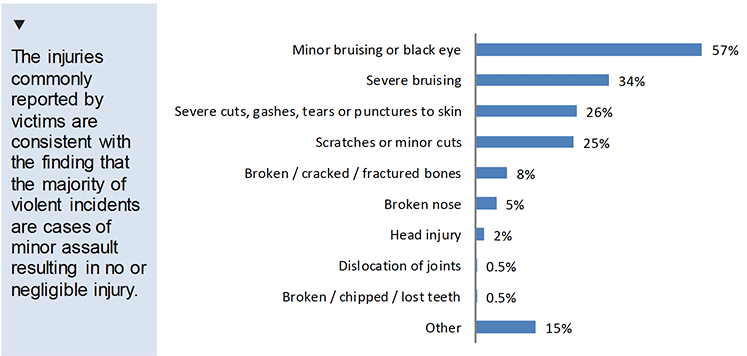
Base: Violent crime incidents where respondent was injured (60); Variable: QINW
Almost half of respondents reported feeling anger as an emotional reaction they felt towards the violent crime they experienced.
In just under half of incidents, the emotional impacts reported by victims of violent crime in 2018/19 were anger (reported in 46% of violent incidents) and annoyance (45%), whilst in 42% of incidents respondents felt shock. Victims in just over a tenth of incidents (11%) said they experienced no emotional impacts, similar to the level in 2008/09 (10%) but down from 27% in 2017/18.
What proportion of violent crime was reported to the police?
The majority of violent incidents in 2018/19 were not reported to the police, a finding consistent with earlier survey years.
The 2018/19 SCJS estimates that two-fifths of violent incidents (40%) were brought to the attention of the police. The reporting rate in 2018/19 was not significantly different from the rate in any SCJS year since 2008/09 (for example, 43% in 2008/09 and 39% in 2017/18) and not significantly different from the reporting rate for property crime in 2018/19 (34%).
There can be a range of factors which influence whether or not an individual reports a crime to the police, not least how the victim views their own experience. The SCJS finds that in around two-fifths of violent incidents in 2018/19 (43%) victims thought their experience should be described as 'a crime' as shown in Figure 3.14 below. Three-fifths (60%) of incidents which victims considered to be a crime were brought to the attention of the police in 2018/19.
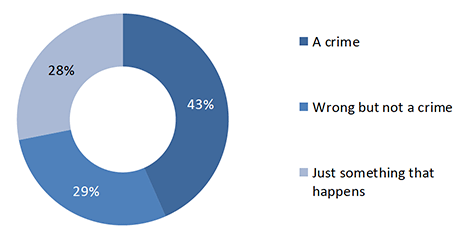
Base: Violent crime incidents (120); Variable: QCRNO
When asked directly why they did not report their experience to the police, victims cited a range of reasons. These included that:
- the experience was too trivial or not worth reporting (25%)
- the issue was considered a private, personal or family matter (23%)
- the belief that the police could have done nothing (16%)
In addition to the options listed in the survey, 'other' reasons were cited in 19% of cases.
Where incidents did come to the attention of the police, victims received information or assistance about the investigation and the case (where relevant) from the police in over half of instances (55%). This is unchanged from 2017/18, but up from 2008/09 (32%). Respondents received information or assistance from the Witness Service/Victim Support Scotland in relation to 31% of incidents, from the Crown Office and Procurator Fiscal Service/Victim Information and Advice service in 18%, and from Scottish Courts and Tribunals Service in 5%. Victims said they had not received information or assistance from any organisation in 13% of cases, whilst a further 19% of incidents were not investigated according to the victim. Respondents' views of the police and the justice system are discussed in more detail in the Public perceptions of the police and the justice system chapter.
What consequences did victims believe offenders should have faced?
About half of victims of violent crime thought the offender should have gone to court, but views varied on what action would have been appropriate.
Regardless of whether the incident was reported to the police, victims in 50% of violent crimes thought the offender should have been prosecuted in court. This proportion has shown no significant change since 2008/09 or in the latest year, and is similar to the proportion of property crime victims in 2018/19 who thought offenders should have been prosecuted in court (51%).
A third (33%) of those who did not think court was appropriate thought the offender should have apologised for what they had done, whilst 30% said nothing should have happened to the offender. Only 3% thought offenders should have been given some kind of help to stop them offending, down from 25% in 2017/18 and unchanged from 2008/09 (8%). Respondents' views of the criminal justice system are discussed in more detail in Chapter 6.
Contact
Email: scjs@gov.scot
There is a problem
Thanks for your feedback